World War I - The auxiliary hospital
The soldiers’ hospital, Queens Road, Royston
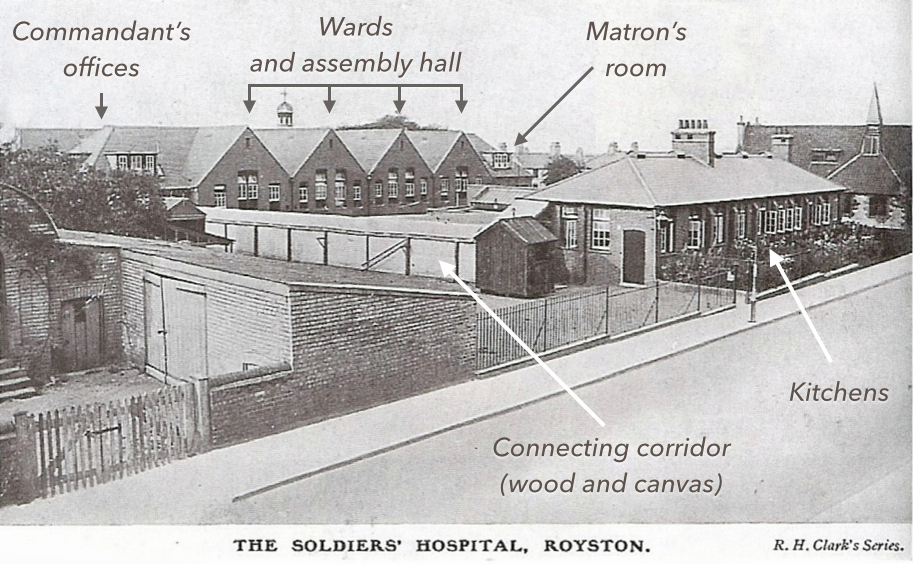
Timeline
October 1909
Building work starts on the school buildings.September 1910
School opens to its first pupils.August 1914
Decision made to convert the buildings for use as an auxiliary hospital for troops recuperation.March 1915
Hospital opens.December 1918
Hospital closes having treated over 2,400 men.1919
Buildings returned to schools use.
Hertfordshire 18 Voluntary Aid Detachment was formed in 1910 as it was feared there would be injured soldiers needing treatment following any future invasion. Membership was open to men and women.
In 1914, it was decided to use the recently built Schools in Queens Road, Royston as a hospital to look after the wounded soldiers from the War front with the Hon. Maud Bevan as its Commandant.
The Auxiliary Hospital received its first patients in March 1915 and by the time it closed in December 1918, had cared for over 2,400 men. Most of the soldiers had no local connection although a few local men were treated there including William Whitehead and J Nightingale from Bassingbourn.
The local communities within Royston and its surrounding district donated food, other items like furniture, books and tobacco and raised funds by flag days, concerts, etc.
There was a Knitting Club linked to a British Red Cross Working Party. Thousands of pieces of clothing were made for the patients and some were sent overseas to the fighting men.
In June 1918, the Hon. Maud Bevan was made a Dame for her work with the British Red Cross.
The hospital staff
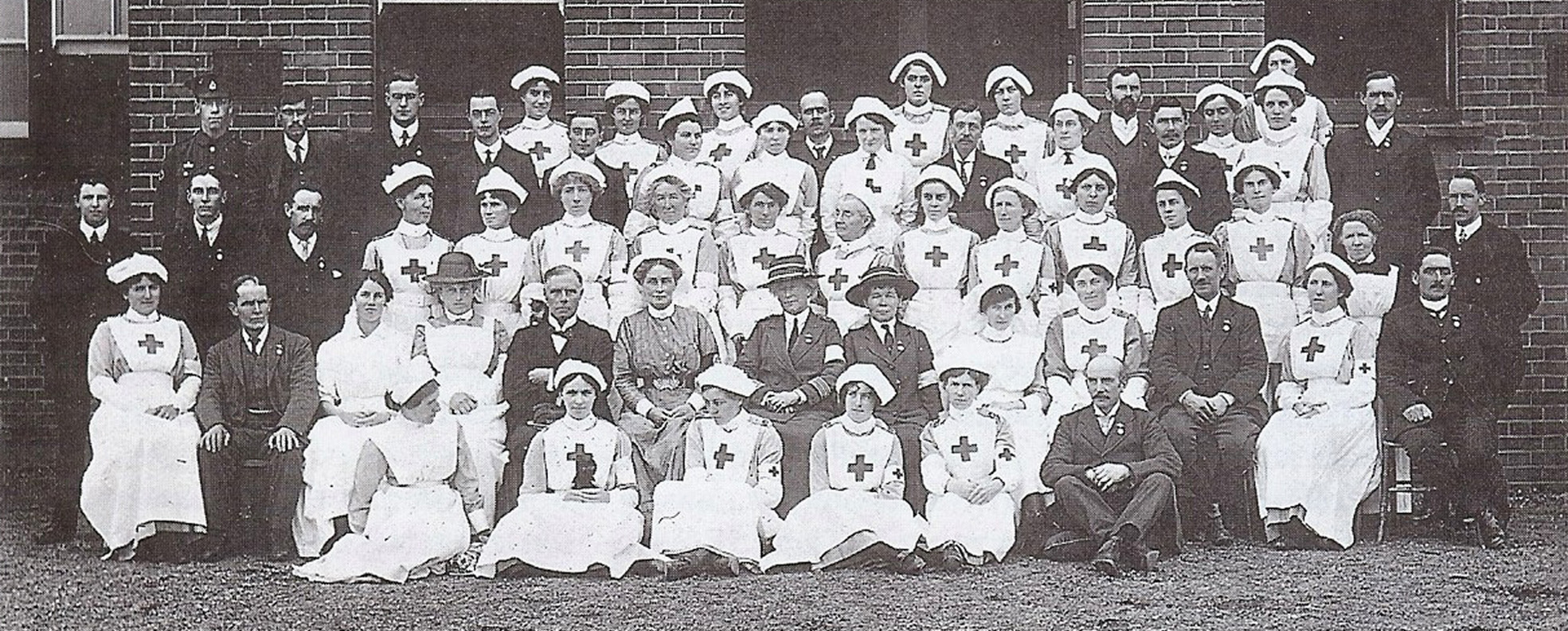
This photograph shows some of the hospital staff (and one small kitten, who’s caught the attention of the two nurses bottom left) who served at the hospital during the Great War.
Some of the staff were trained nurses, some were paid but the vast majority were volunteers, mainly women but some men too. Children also played their part. Some of the Volunteers took first aid courses; others cleaned the building and cooked and sewed for the men.
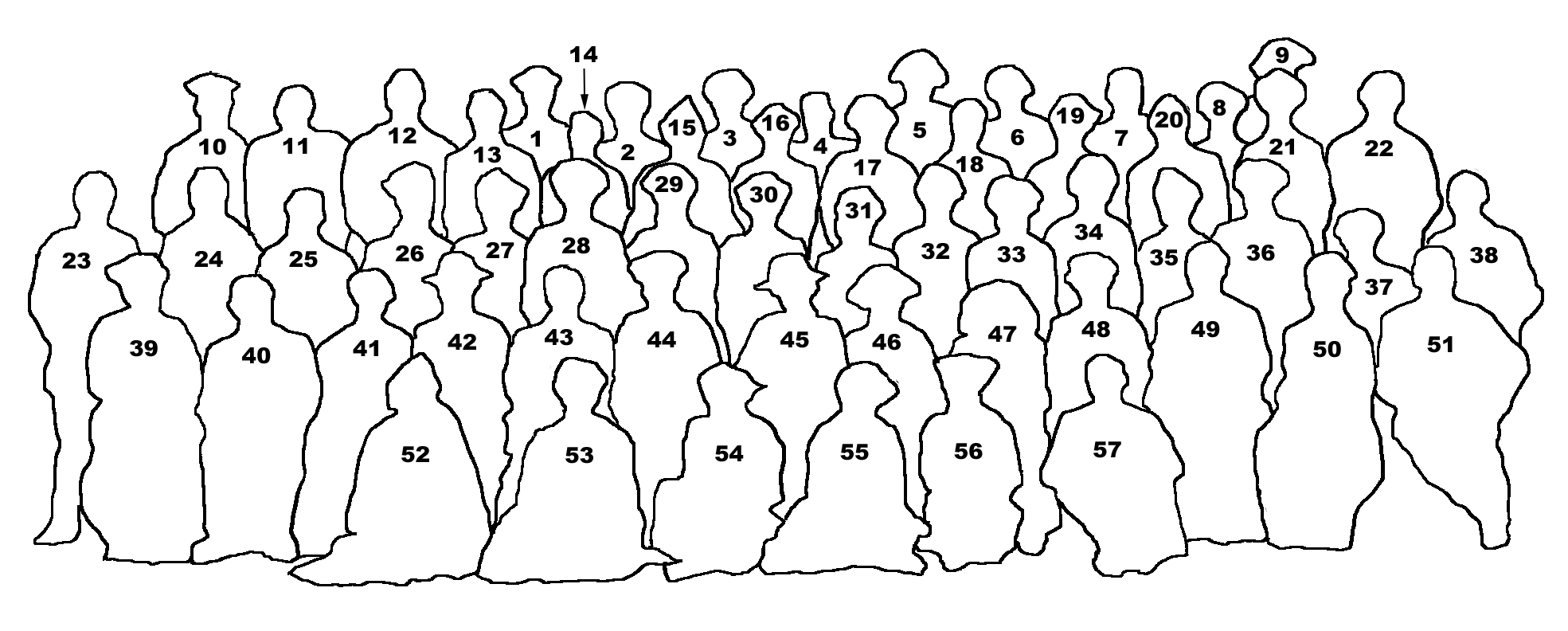
Can you help?
Contact the project teamThese are some of the names discovered to have been associated with the Auxiliary Hospital, Royston.
Can you help to match the names below to the people in the photograph? Please contact the project with any information which may help us put the names to the faces.
Some of the hospital staff noted in the Royston Crow
20th January 1919
Regular weekly scrubbers (cleaners)
Mrs Ellen Louise Cowell
Mrs Ellen Day
Miss Mary Robinson
Mrs Elizabeth Titmus(s)
Mrs Elizabeth Wake
British Red Cross working party
Miss Caroline Phillips
Miss Rosa Beale
Members of detachment
Miss Daisy Clarke
Miss Minnie Disbrey
Miss Ella Phillips (later Bell)
Miss Agnes Stockbridge
Mr Charles Henry Bullard
Mr Fred Dellar
Mr Reuben David Ebbutt
Mr Percy Jacob
Mr William J Wilkerson
Mr John Williamson
Dr Charles W Windsor
8th October 1921
Assistant Commandant
Mrs Bell (formerly Ella Phillips)
Mrs Mary Beasant (until 1916)
Quartermaster
Mrs Alice Isabel Fordham
Mrs Eva Marie Windsor
British Red Cross Matron
Mrs Sybil Cockburn
Hon Treasurer
Mr Alfred William Deards
Members of detachment
Miss Irene Mary Archer
Miss Margaret (Mag) Boucher
Miss (Rhoda) Geraldine Boucher
Miss E Brown
Mrs J Buchanan (nee Nancy Bevan)
Miss Margery Cross
Miss Mable Crossley
Miss Mary Constance Greenstreet
Miss Florence Camilla Grundy
Miss M Innes
Miss Dorothy Jacklin
Miss Catherine Nash
Mrs W Nash Woodham
Miss Agnes Stockbridge
Mrs Vessey (?)
Mrs (possibly Hilda Agneta) Webb
Red Cross service cards
The Red Cross has published scans of the cards setting out details of the service provided by those involved with the various hospitals they ran during the Great War. These service cards have revealed just how much help was received, in many different ways, from those who volunteered for work.
Ellen Day
Ellen worked as a volunteer at the Soldiers Hospital from 1915 to 1918, half a day a week cleaning wards and was awarded a Red Cross certificate in 1919.
Born in Norfolk, Ellen came to Royston with her husband Charles. They are in Royston by the 1881 census. He worked as a groom or cab driver and later as a nursery gardener, whilst Ellen was a dressmaker.
Their children were Benjamin and Sidney.
They lived at the Green, Kneesworth Street and later in Queens Road.
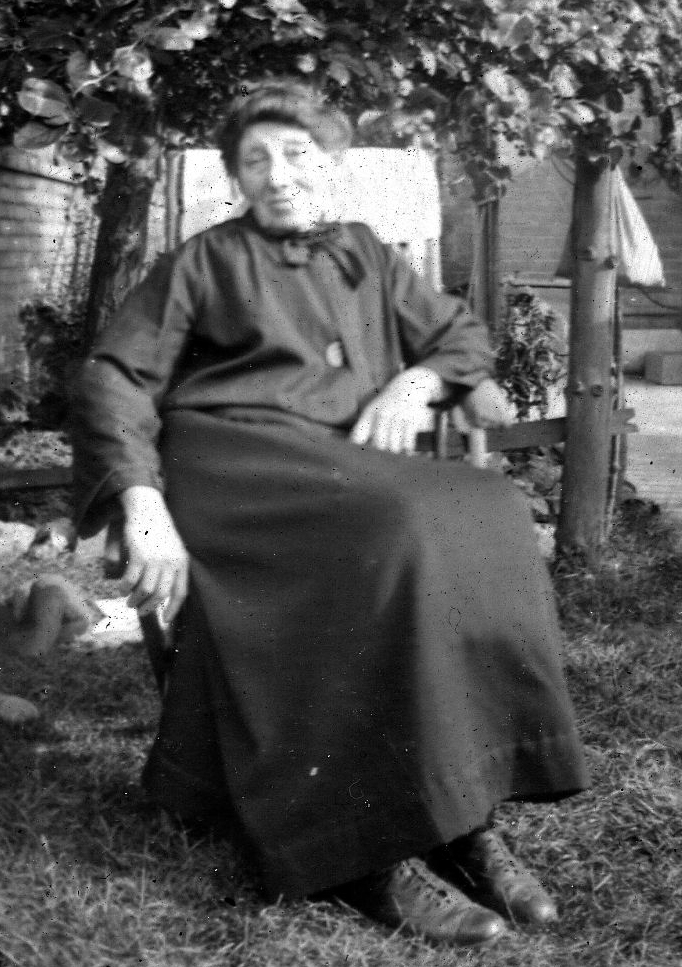
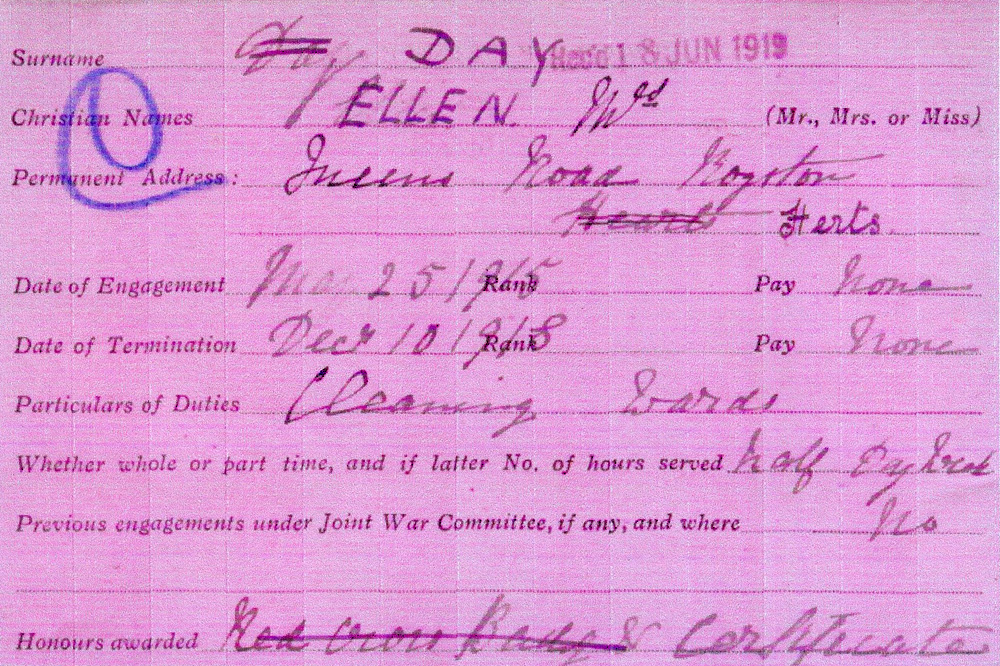
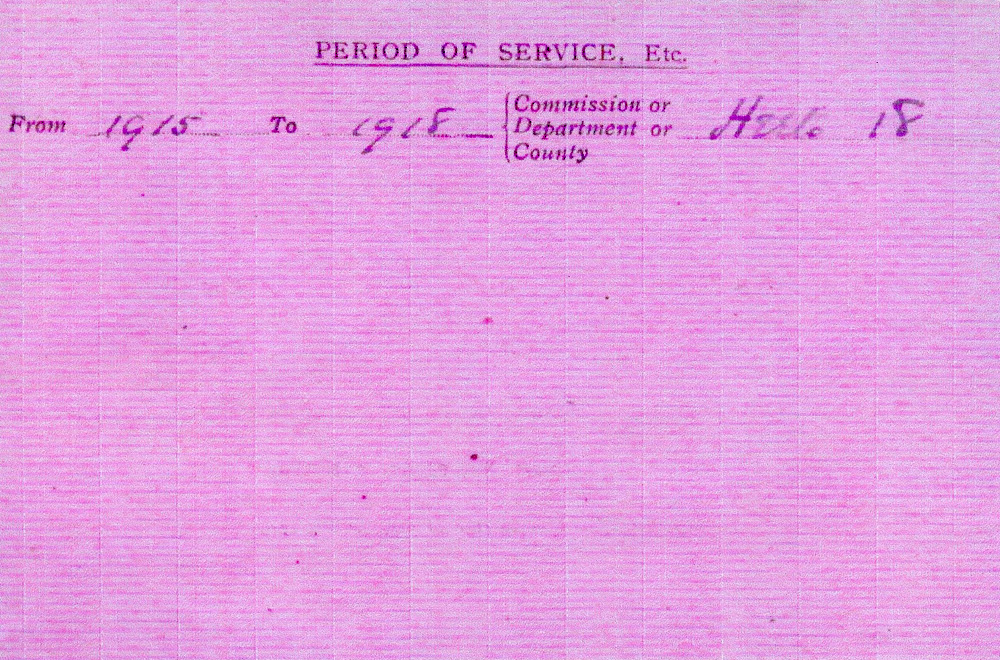
Charles Henry Bullard
Charles was a basket maker and china dealer who was a regular night orderly working 12 hours a week between 1915 and 1918.
Daisy Clark
Daisy was a head of the Infants’ school and a nursing member with 5,000 hours served between 1915 and 1918.
Ellen Louise Cowell
Ellen scrubbed and cooked 14 hours a week from 1915 to 1919.
Eliza Jane Sewell Cautherley
Eliza organised the work of the kitchen and acted as caterer and cook working a full day of 14 hours in 1915. It was quite impossible to estimate to number of hours given.
Annie Ada Bourne
Annie darned 400 pairs of socks between 1915 to 1918.
Inside the hospital
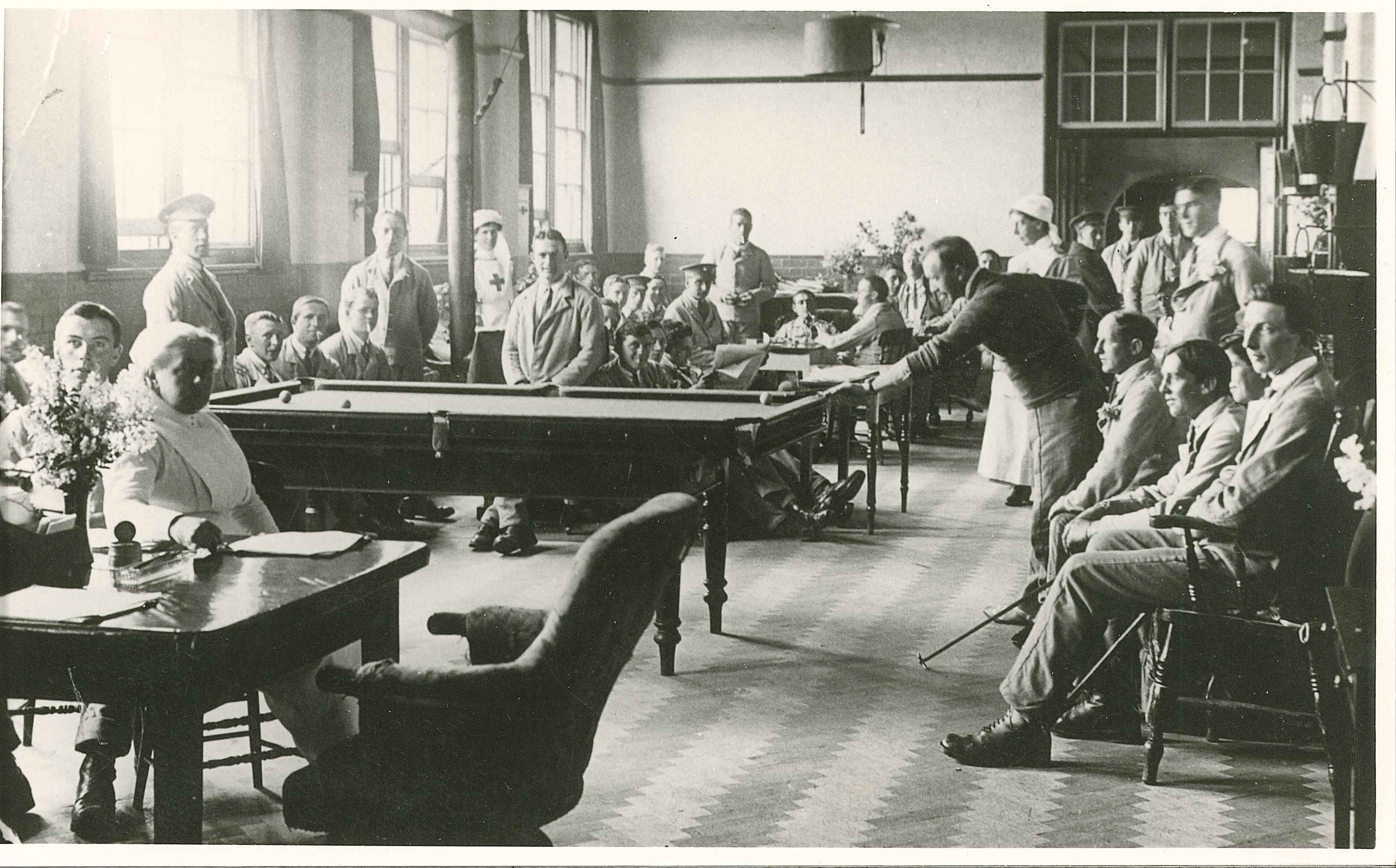
The commonroom in the Auxilliary Hospital
Photograph by kind permission of Royston Museum.
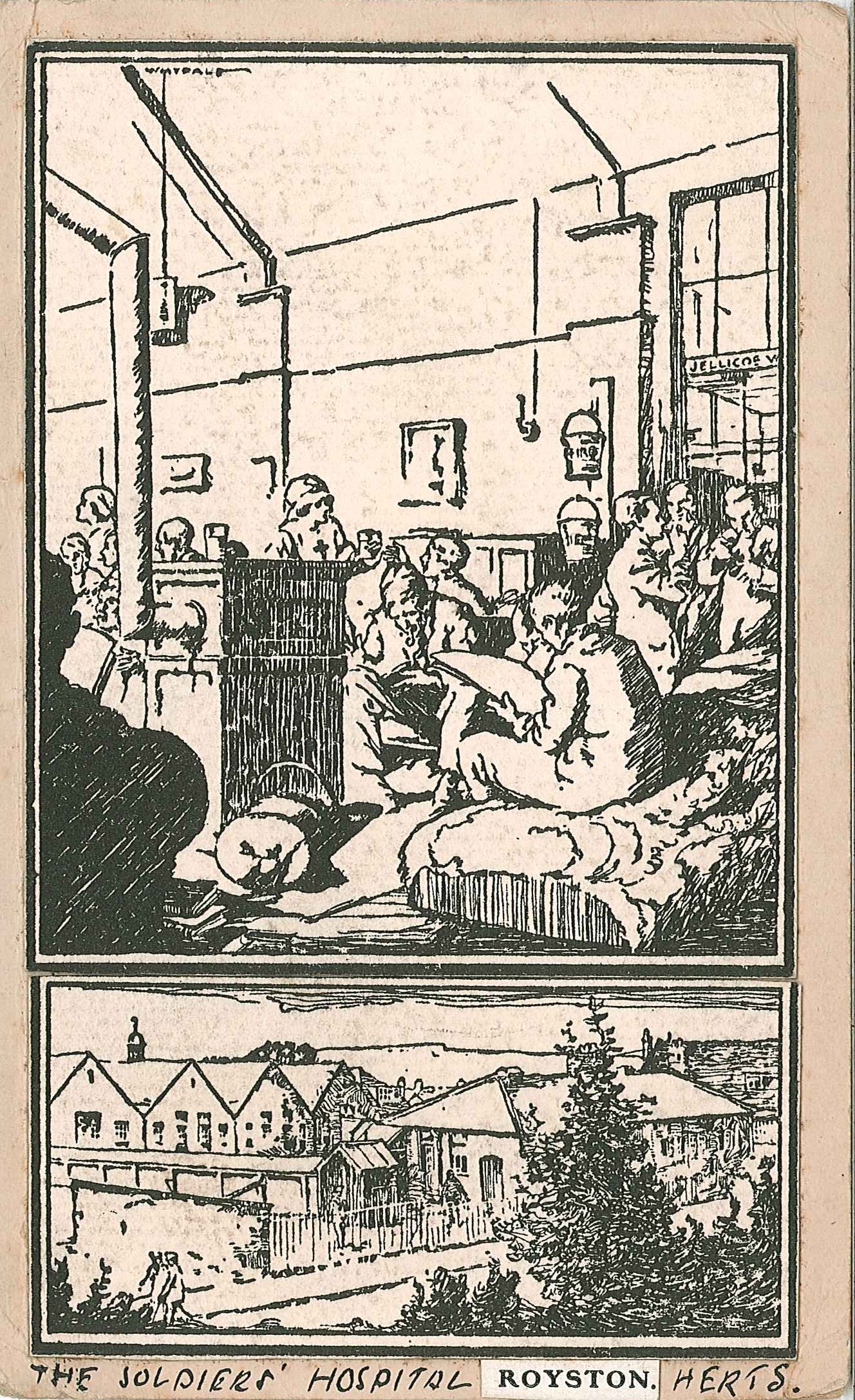
Illustration by Ernest Herbert Wydale, by kind permission of Royston Musem.
"The four wards which are at present furnished and occupied are on the south side of the building, and over each ward is the name of a prominent man of the present war. They are French, Jeffre, Jellicoe and Kitchener. Each ward contains at present six beds and there is a different kind of colour scheme worked out in the hangings, etc., in each ward that has a particularly pleasing and cheerful appearance.
"The wards are 25 feet by 24 feet and correspondingly lofty. The Central Hall is 48 feet 9 inches by 20 feet, and this is used partly as a mess room and recreation room, the division being made with movable screens. Small tables are provided for games, writing, etc., and there is also a piano. There are three other large class-rooms on the north side of the building, which if required can be furnished and on the same scale as the other wards will accommodate 18 additional patients. The hospital has, however, been scheduled to take 50 patients if required."
From an article in the Royston Crow,
2nd April 1915
The patients
There are no admission books available but a number of soldiers are mentioned in the Crow newspaper articles throughout the period. These included Canadian Archibald MacMurdy of the 15th Scottish Canadian Highlanders, who supported a recruitment drive in June 1915, and Australian William Farrell of 55th Battalion Australian Imperial Force who wrote to the paper praising how the Home for Little Girls was run in October 1916.
The only comments we can find on the hospital by a soldier are those by Fred Allwood, a Derbyshire born member of the Australian forces who was treated there in June 1917.
The story of Fred Allwood was inspired by letters to his sweetheart, compiled by Alan James. In this extract Fred compares life and the care he receives while at the 1st Great Eastern Hospital in Cambridge (from where he writes) and the Auxiliary Hospital in Royston.
"Royston has built me up again. I am hard and well again and now I am here again [1st Eastern Hospital, Cambridge] in the prison like hospital with liberty for 3 hours only every day and nothing to do in the remainder feeling fit and ready for anything.
"Sister Cockburn gave us a splendid time the Tuesday before we left Royston. She lives at Baldock about 9 miles away and she invited the Sgt to pick a tennis team of four to play against her team at Baldock. The team was made up of 2 British and two Australians inc your boy and we drove over and had a right royal time. She and her husband and another lady and gentleman played against us. They beat us but we enjoyed it, she gave us a splendid dinner and a good tea on the tennis ground.
"I miss the tennis and cricket and I haven't enjoyed a meal here yet."
Extract from "A Most Unremarkable War"
by kind permission of the author, Alan James
The hospital’s closure
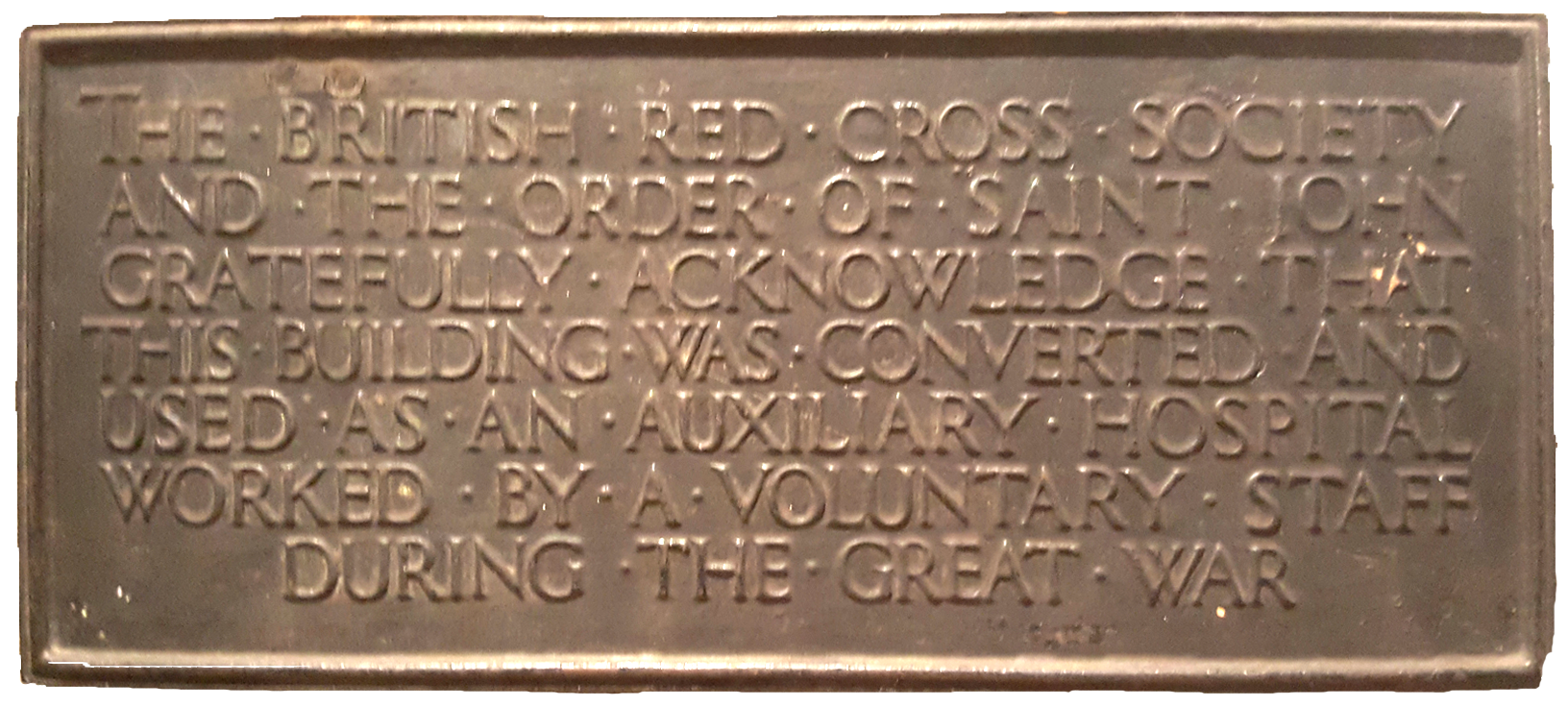
Plaque later attached to the reopened schools building in recognition of the role they played as a hospital in World War I .
The plaque is in the collection of Royston Museum.
The Auxiliary Hospital closed during the week which ended on 21st December 1918. This gave the members of the Voluntary Aid Detachment (VAD) and other supporters a chance to reflect on their work mainly over the 1915 to 1918 period but acknowledging how it all started in 1910 when Herts 18 VAD was set up.
A triple celebration took place at the Schools to mark the end of the War, the closure of the hospital and Christmas.
Herts VAD 18 continued after the War. The children returned to the Schools in 1919 which finally closed in 1969. The buildings were knocked down and the current housing was built.
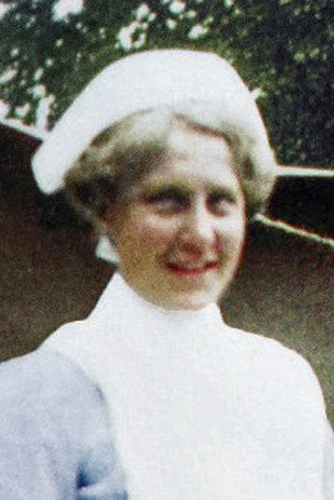
Sybil Cockburn
The Royston Crow’s report on the closure
“A visible link in our midst with the agony of war for three years nine months.
The wounded soldiers have been popular with the people and have conducted themselves in such a way that warm friendships have been fostered that will remain for some long time to come.
"They have always spoken of the hospital with the highest praise. The absence of the familiar blue and grey hospital uniform will be missed from our town and the girls in blue too.
"Royston too feels proud of the patriotic band of workers who have so loyally rendered service at the hospital many of them for the whole time it has been opened. It has indeed been a fine example and credit to themselves and the town.
"The hospital was fortunate to have for its commandant the Hon. Dame Maud Bevan, the president of the British Red Cross Society for Hertfordshire, whose organising ability has been conspicuous from its commencement and whose tact and personality won the loyal and wholehearted service of the Detachment and helpers which is a such an incentive and encouragement to a leader.
"In June last among the King’s birthday honours the Hon. Mrs. Bevan was distinguished by being created a Dame of the order of the British Empire. Her second-in-command Miss Ella Phillips has also had her valuable services officially recognised as her name was included in the list of lady members of the nursing brought to the attention of the Secretary of War published in October 1917.
"Several other members of the VAD have had similar recognition of their services [Inc. Miss Dorothy Jacklin and Miss Daisy Clark] and the matron Mrs. [Sybil] Cockburn in August last at an investiture by the King at Buckingham Palace was decorated with the Royal Red Cross, second class VAD."
The Red Cross
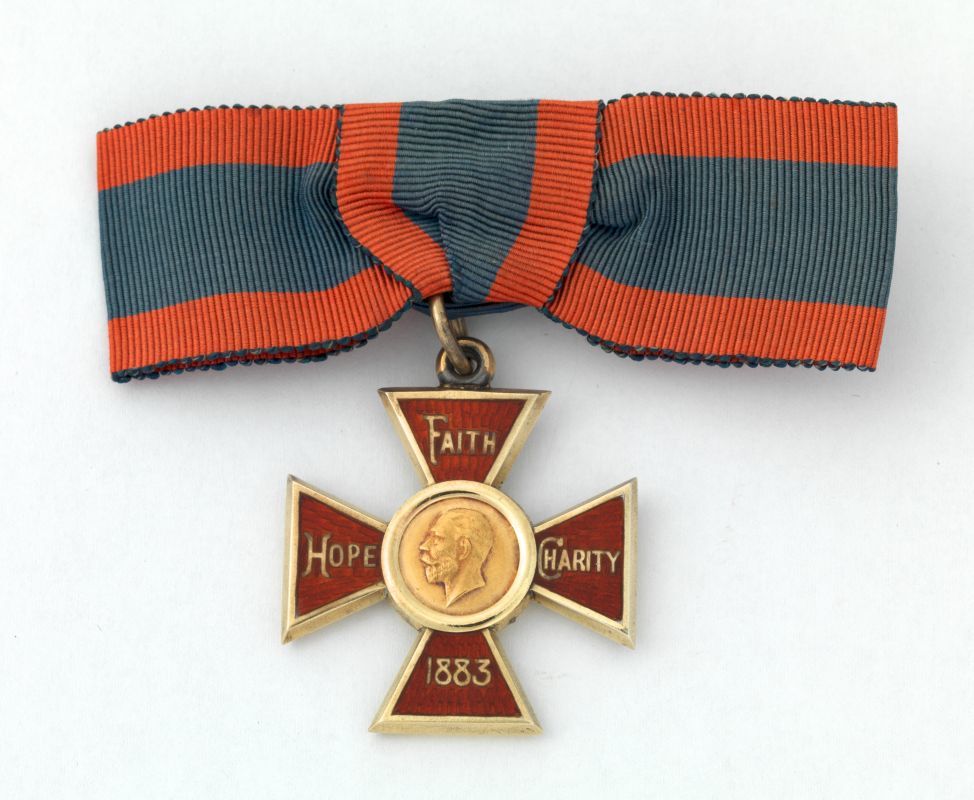
The Royal Red Cross was instituted by Queen Victoria in 1883 and was the first example of a British military order solely for women.
The decoration can be conferred upon members of the nursing services, irrespective of rank. It can also be given to anyone, British or foreign, who has been recommended for special devotion or competency while engaged on nursing or hospital duties in the navy, army or air force. Since 1917, it can be conferred on male members of the nursing scheme.
Recipients are designated “members: and can use the letters “RRC” after their names. The badge is in the form of a red cross, in gold with red enamel. The words “Faith, Hope, Charity” are engraved on the arms of the cross with the date of institution, 1883. In the centre, in relief, is the royal effigy and on the reverse, the Royal Imperial Cypher and crown.
Royal Red Cross, second class, was instituted during the Great War of 1914-18. Recipients are called “associates” and can use the letters “ARRC” after their name. The badge is almost the same but in silver instead of gold.
Despite the title, the order has no connection with the Red Cross movement, though a number of women members of the British Red Cross have received the award in recognition of the nursing services performed with the British navy, army or air force.